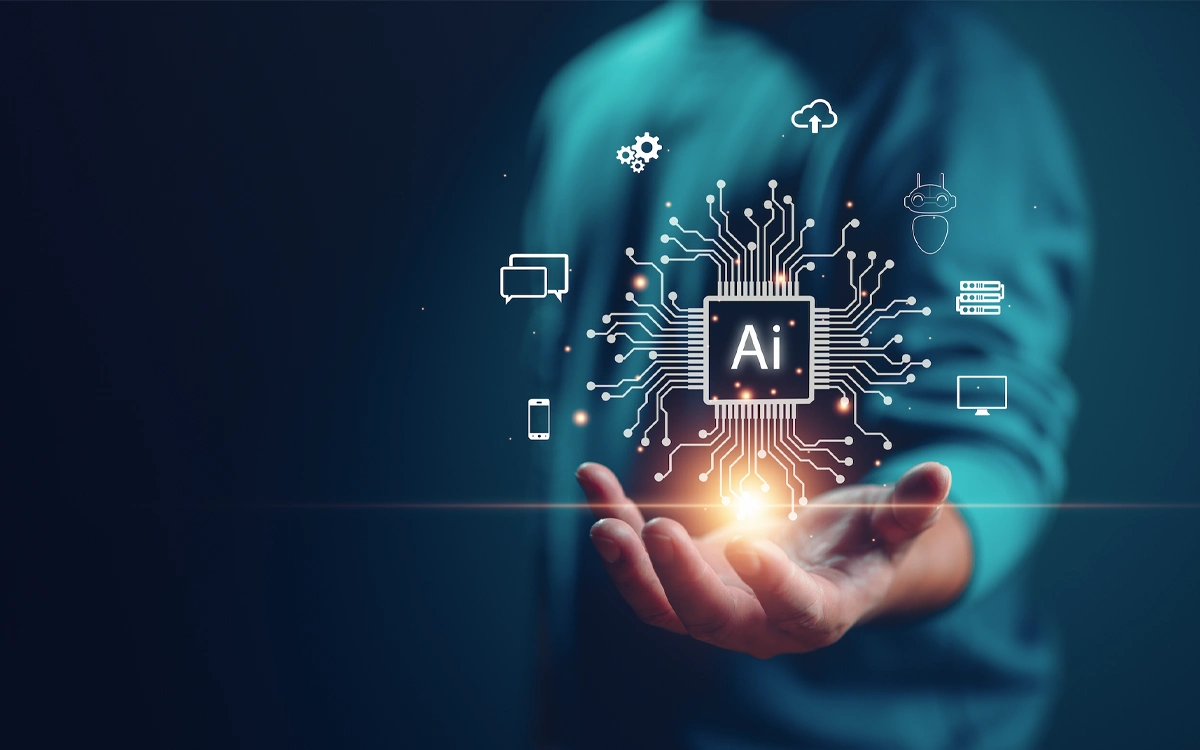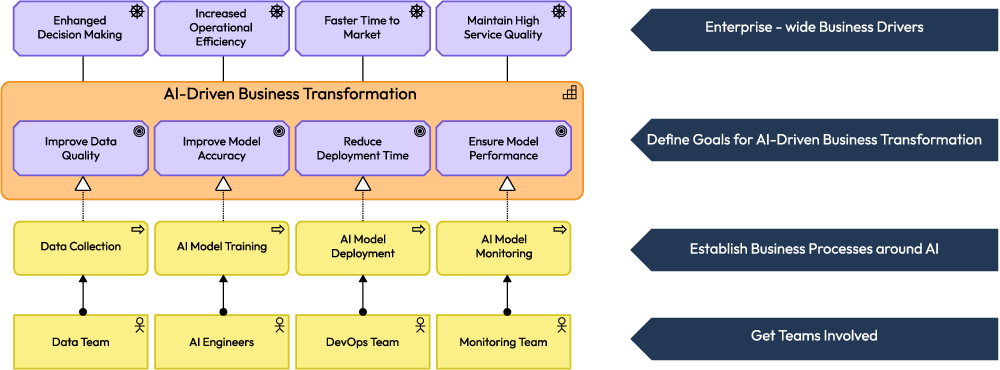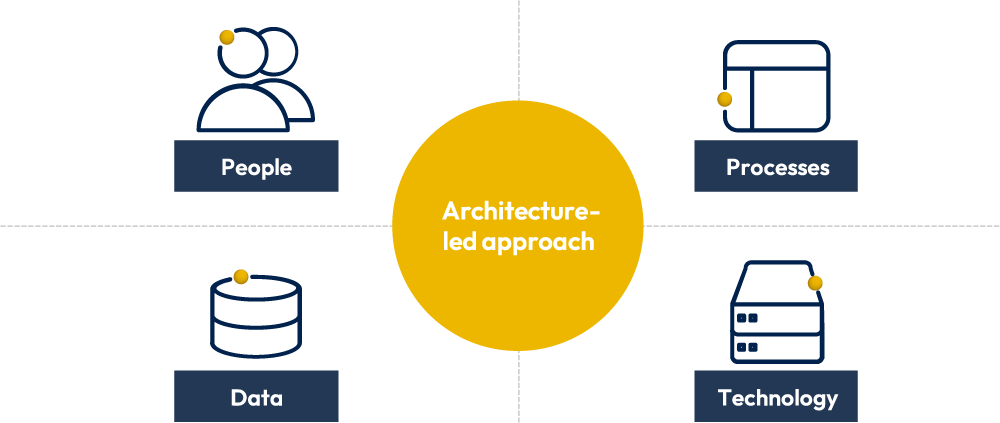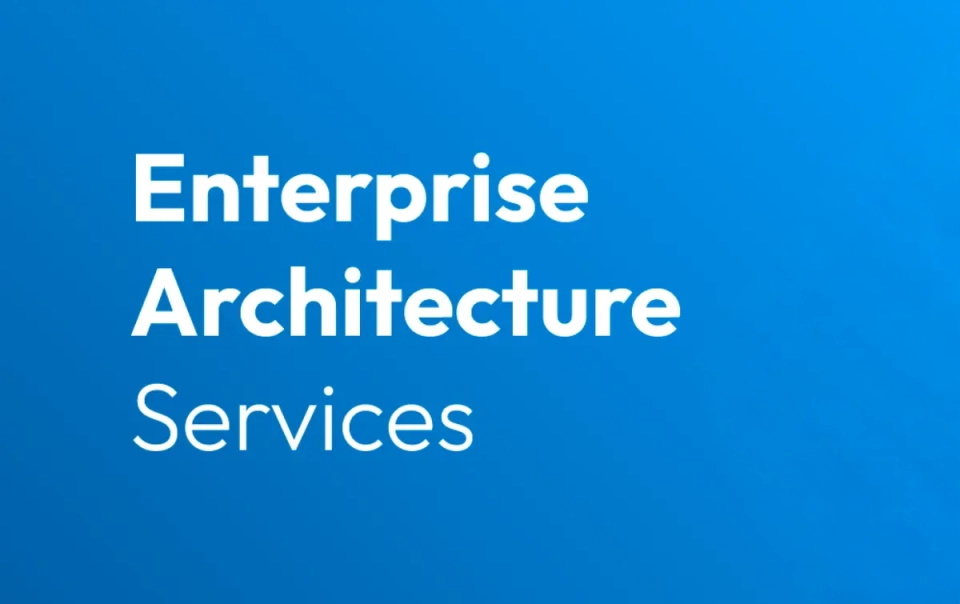The Future of Enterprise Architecture and AI Integration

‘The future of enterprise architecture’ is increasingly intertwined with Generative AI, which isn't merely a fleeting trend. Generative AI is a transformative tool that can diagnose medical conditions by predicting machinery failure or directing traffic and goods flow. Moreover, its symbiotic relationship with machine learning (ML) reshapes IT structures and enterprise architecture.
Future of enterprise architecture in the Generative AI era.
Having a legacy spanning over three decades, enterprise architecture now faces the formidable task of navigating the burgeoning field of AI. The rapid technological advancements require enterprise architects to be nimble in recognizing potential trends, implementing transformative processes swiftly, and handling vast data volumes with finesse.
To surmount these challenges, there's an urgent need for a transparent, holistic enterprise view. Enterprise architecture tools are invaluable in this quest, facilitating collaboration across various sectors. It enables organizations to assimilate diverse inputs efficiently and establish informed decision-making foundations.
Generative AI and ML: Reframing strategic approaches
Today, AI and ML dominate the IT sector. Their applications include:
- Countering cyber threats
- Refining IT management processes
- Deciphering patterns, trends, and anomalies that elude human scrutiny
These technologies:
- Curate data models
- Provide predictive insights
- Orchestrate scenarios based on multiple data sources
Signifying this paradigm shift, Andrei Karpathy, a computer scientist who served as the director of AI at Tesla, insightfully remarked on X, "The hottest new programming language is English." The strides in AI, especially natural language processing, mean that software creation isn't confined to traditional coding.
AI can transmute human language instructions into operational software. This breakthrough has significant ramifications for enterprise architecture, making technology more accessible and democratizing it for non-technical users.
Using the right tools is paramount for successfully integrating AI into enterprise architecture. Enterprise architecture tools help organize and visualize the vast complexities of current systems and future AI integrations. Bizzdesign Horizzon is a comprehensive enterprise architecture tool that aids organizations in aligning their AI objectives with their enterprise architecture framework.
With tools like Bizzdesign Horizzon, businesses can ensure that AI integrations are strategic, cohesive, and in line with organizational goals, thereby optimizing the potential benefits of AI.
Harmonizing AI deployment in organizations
An organization's Generative AI deployment strategy must be architecture-led or, at a minimum, influenced by architecture. Successful AI integrations aren't solely about the technology but harmonizing people, processes, data, and technology. While AI's capabilities are vast, the value of genuine human interactions, particularly in client engagements, remains irreplaceable.
However, enterprise architecture and AI benefits aren't exclusive to global giants. Businesses of all sizes should delve into these subjects, seeking guidance from experts like Bizzdesign to strike a delicate balance.
This balance involves leveraging AI's transformative potential while being mindful of the swift pace of its evolution. Moreover, as AI models advance, their computational power needs grow.
It's vital to consider AI software costs and the necessary infrastructure support. With dynamic market shifts, security concerns, and regulatory uncertainties, companies need a sound architectural foundation.

AI-Driven Business Transformation as an Accelerator
Operationalizing AI in the organization
Implementing AI necessitates harmony between humans, processes, data, and technology. AI's integration should be user-centric, ensuring comprehensible, actionable outcomes.
Clear AI training and deployment processes are essential, emphasizing the data's availability, quality, and management. This involves crafting a robust data infrastructure and meticulous data integration, purification, privacy, and security processes.

Adopting AI needs Enterprise Architecture
Understanding enterprise architecture lays the groundwork for agile processes, equipping companies for success in an ever-evolving global landscape.
Bizzdesign’s AI Center of Excellence
Bizzdesign’s AI Center of Excellence brings the capabilities of artificial intelligence to Bizzdesign Horizzon, its SaaS enterprise architecture platform. As part of this initiative, Bizzdesign has launched the Relation Recommender for ArchiMate, which streamlines and accelerates modeling work for architects by automating the selection of relationship types when connecting components in architecture models.
Additionally, Bizzdesign's AI Center of Excellence is actively working on expanding its Generative AI capabilities in Bizzdesign Horizzon, with more exciting developments to be released soon:
- Reference Architecture for Generative AI: To support and guide customers in adopting generative AI at scale in their enterprise, this reference architecture contains a valuable set of principles, guidelines, controls, and capabilities that organizations need to consider, align, and adopt to realize the benefits of generative AI while also managing the risks.
- “How to Coach” AI Assistant: An AI assistant trained on Bizzdesign’s product documentation and knowledge base that guides users in getting things done in Bizzdesign Horizzon.
- Bizzdesign AI Bot: Enables natural language queries of the Bizzdesign repository that empowers non-technical business users to get the insights and answers they need to drive better and faster transformation.
- Diagram Importer: Converts unstructured diagrams into structured models using cognitive AI, eliminating the need for file conversion covering formal notations and unstructured diagrams such as whiteboard sketches.
For more information, you can read the full press release about Bizzdesign's AI initiatives here. In conclusion, the race towards digitization and AI integration in enterprise architecture is ongoing, with no slowdown. With the right tools, like Bizzdesign, and a comprehensive approach, organizations can successfully navigate this complex journey, reaping AI's manifold benefits.



